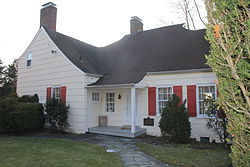Cornelius Van Wyck House
|
Cornelius Van Wyck House
|
|

The house dates to 1735.
|
|
| Location | 126 West Dr., Douglaston, Queens, New York 11363 |
|---|---|
| Coordinates | 40°46′23.8″N 73°45′9.0″W / 40.773278°N 73.752500°WCoordinates: 40°46′23.8″N 73°45′9.0″W / 40.773278°N 73.752500°W |
| Area | less than one acre |
| Built | 1735 |
| Architectural style | Dutch Colonial |
| NRHP reference # | 83004149 |
| Significant dates | |
| Added to NRHP | October 6, 1983 |
| Designated NYCL | April 19, 1966 |
The Cornelius Van Wyck House is an 18th-century Dutch Colonial home located on the shore of Little Neck Bay in the Douglaston section of Queens in New York City. This house overlooks Little Neck Bay and is well known for both its age and architecture, and especially for its original owners. It was designated as a landmark by the New York City Landmarks Preservation Commission in 1966 and added to the National Register of Historic Places in 1983. The Cornelius Van Wyck House is considered to be the "most impressive architectural remnant of the early Dutch Culture" in New York.
The history of the Cornelius Van Wyck estate predates the construction of the Van Wyck house. Cornelius Van Wyck's father, Johannes Van Wyck, purchased 125 acres of land from Richard and Sarah Cornell. This property was inherited by Cornelius when his father died in 1734.
The house was originally constructed in 1735 by Cornelius Van Wyck, a third-generation American. Cornelius and his wife Mary Hicks added to their original farm and lived in the house until his death. Upon his death, the house passed to his son Stephen Van Wyck, who built additions to the house. However, Stephen, the eldest of Cornelius' 3 sons, showed no interest in farming; therefore, he sold his share of the inheritance to his cousin Cornelius, who was the last Van Wyck to live in the home.
In 1819, possession of the home left the Van Wyck family when it was sold to Winant Van Zandt. Van Zandt, who was wealthy, had purchased 120 acres of adjoining land to the north (referred to as the "Point" area of Douglas Manor). In 1819, Van Zandt constructed a large mansion on the Point. Upon George Van Zandt's death, his son William inherited the property. During the tenure years in which the Douglas family owned the Cornelius Van Wyck House, the estate was used as a guest house and was sometimes rented to friends.
The original Cornelius Van Wyck House, according to a news article, became a "gate house" and led to the larger mansion, which later became The Douglaston Club.William Douglas sold the entire tract in 1906 to the Douglaston Club. The smaller house was purchased by Edward Wicht in 1915; Wicht restored the structure to its original condition and furnished it in keeping with the design and architecture of the previous structure. When Wicht died in 1936, Mr. and Mrs. Larsen purchased the house. Mrs. Larsen showed interest in the history of the homestead. This family also worked to maintain the house and furnish it as it was originally designed and built.
...
Wikipedia



